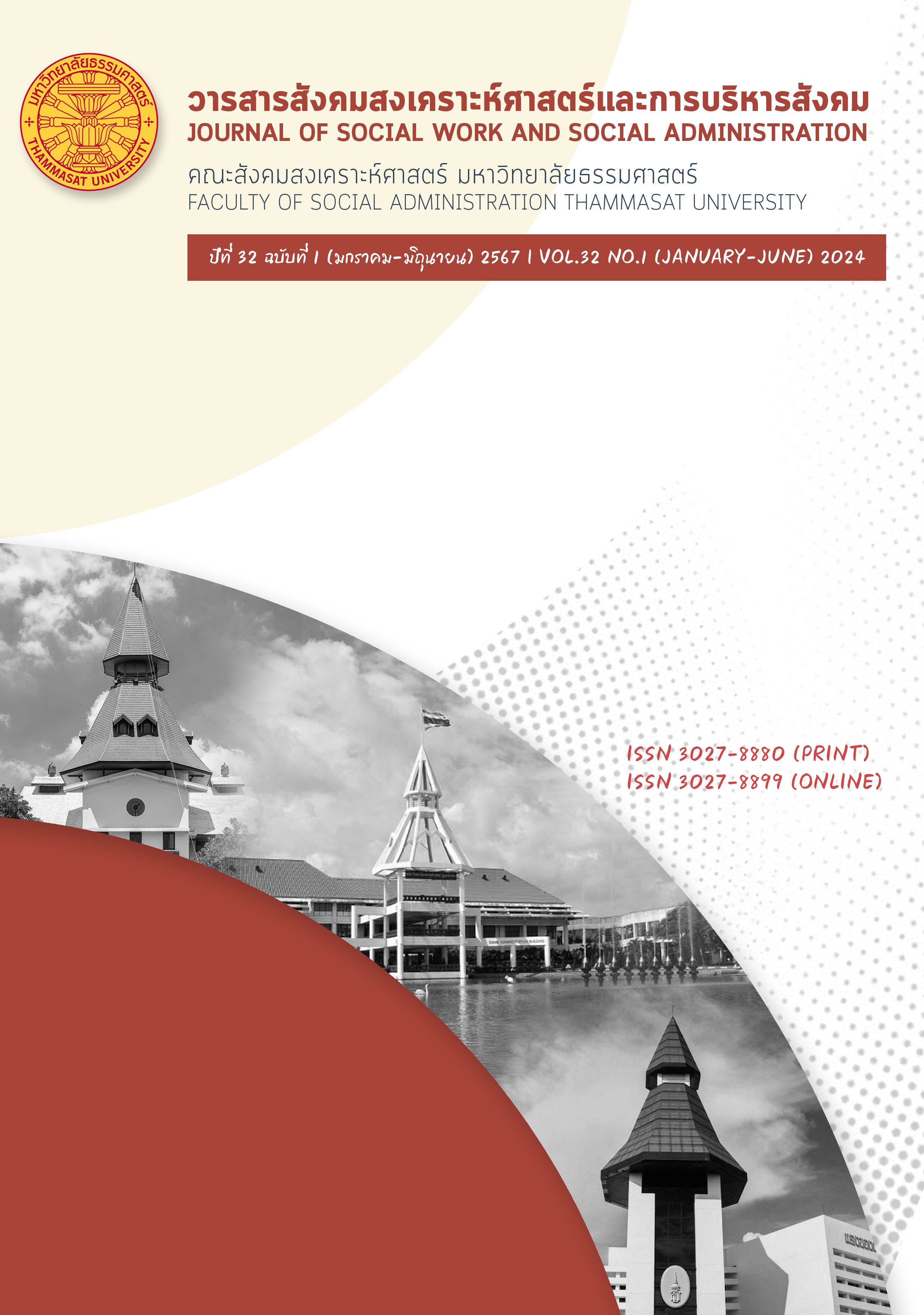Performance evaluation of Bueng Yitho Day Care and Day Service Center for the Elderly
Keywords:
Day Care and Day Service Center, Elderly, Evaluation, CIPPiest ModelAbstract
This research is an evaluation study research employing the CIPPiest Model. Its purpose is to study the provision of services, assess performance, and identify areas for further improvement in the operations of day care centers for the elderly, established by Bueng Yitho Municipality in 2019 as an alternative service for the elderly in the community. There were approximately 30 service users, specifically 7-10 persons daily. Based on the results of the operational assessment, all criteria have been achieved as follows: 1) Context: The municipality's policies were in line with those executed by the government. The number of elderly individuals in need of rehabilitation has been increasing, creating an atmosphere conducive to the concrete establishment of the center; 2) Input: Personnel, budgets, documents, and planning and implementation time were found to be appropriate; 3) Process: the municipality has prioritized systematic management, service provision, and evaluation with established mechanisms and tools; 4) Output: a range of activities spanning health, physiotherapy, and social and psychological care for both group and private services were offered on a case-by-case basis while the elderly were regarded as the core of the services; 5) Impact: caregivers receivesupport and relief from elderly caretaking tasks during the day. Moreover, the center was recognized by the HAPI Award in the field of community initiatives from Japanese, thus creating an impact on international organizations; 6) Evaluation of effectiveness: the services enable the elderly to engage in more daily activities, maintain physical condition, and promote self-reliance; 7) Sustainability: the center has continuously provided services and developed their operation into a training center; and 8) Knowledge transfer: ongoing knowledge exchange with at least 2 local government organizations interested in establishing a center. For as suggestions for the development, the municipality should develop and apply technology in services offered to the elderly and consider acquiring additional staff for certain positions, e.g., facilitators and social workers, to complete the service integration across all facets. At the operational level, public awareness should be raised through increased public communications and involvement of families and communities to support elderly care. A wider variety of activities should be developed to allow the elderly to choose activities they are interested in independently.
References
นงลักษณ์ ลีลาสุธานนท์. (2565). การประเมินผลการดูแลผู้สูงอายุที่มีภาวะพึ่งพิงของโรงพยาบาลส่งเสริมสุขภาพตำบลจังหวัดกระบี่, วารสารอนามัยสิ่งแวดล้อมและสุขภาพชุมชน, 7(3), 68-77.
นูรรีย๊ะ ล่าเตะเกะ, อิสมาแอ ล่าเตะเกะ และ รอฮานี อิสลามิกกุล. (2564). การพัฒนารูปแบบบริการผู้สูงอายุแบบไปเช้าเย็นกลับ (Day care) ตามบริบทชายแดนใต้ กรณีศึกษาผู้สูงอายุ และผู้ดูแลผู้สูงอายุ องค์การบริหารส่วนตำบลเปาะเส้ง อำเภอเมือง จังหวัดยะลา. วารสารวิชาการสาธารณสุขชุมชน, 7(1), 98-109.
พิชามญชุ์ สุวรรณฉัตร, ภัทรัตน์ ปานสุวรรณจิตร์ และ วิชุดา จิรพรเจริญ. (2564). ผลลัพธ์ของโปรแกรมการดูแลผู้ป่วยระยะกลางในการเพิ่มความสามารถการดำเนินกิจวัตรประจำวันของผู้ป่วยโรคหลอดเลือดสมอง ผู้ป่วยบาดเจ็บไขสันหลังและผู้ป่วยบาดเจ็บที่ศีรษะในโรงพยาบาลสารภีบวรพัฒนา จังหวัดเชียงใหม่. วารสารสาธารณสุขล้านนา, 17(2), 78-90.
ศุภามณ จันทร์สกุล. (2557). ยุคสมัยของการประเมินผลและแนวคิดทฤษฎีของนักประเมิน. วารสารวิชาการมหาวิทยาลัย อีสเทิร์นเอเชียฉบับวิทยาศาสตร์และเทคโนโลยี. 8(1), 68-79.
สุรสิทธิ์ วชิรขจร (2559). การประเมินการดำเนินงานของสภาองค์กรชุมชน. วารสารมนุษยศาสตร์สังคมศาสตร์ มหาวิทยาลัยทักษิณ, 11(2), 31-58.
สุมิตรา วิชา, ณัชพันธ์ มานพ, สุภา ศรีรุ่งเรือง, เบญจพร เสาวภา, ศิริรัตน์ ศรีภัทรางกูร, ณัฐกานต์ ตาบุตรวงศ์, ธณกฤษ หมื่นก้อนแก้ว และธนัชพร มณีวรรณ. (2560). การพัฒนาระบบเครือข่ายบริการสุขภาพสำหรับผู้สูงอายุกลุ่มติดบ้านและกลุ่มติดเตียง (กรณีศึกษาผู้สูงอายุกลุ่มติดบ้าน และกลุ่มติดเตียงในเขตรับผิดชอบของ รพ.สต. ฮ่องห้า อ. แม่ทะ จ. ลำปาง). กรุงเทพฯ: สถาบันวิจัยระบบสาธารณสุข (สวรส.)
อรพรรณ ศฤงคาร, อังสนา บุญธรรม, สุคนธา คงศีล, สุขุม เจียมตน และ ภูษิต ประคองสาย. (2564). ต้นทุนต่อวันนอนในการให้บริการการดูแลระยะกลางในผู้ป่วยโรคหลอดเลือดสมองในโรงพยาบาลตติยภูมิแห่งหนึ่ง, วารสารวิจัยระบบสาธารณสุข, 15(4), 407-421.
Burch, S., & Borland, C. (2001). Collaboration, facilities and communities in day care services for older people, Health & Social Care in the Community, 9(1), 19-30.
Department of Health. (2001b). HSC 2001/1: LAC Intermediate Care. London: HMSO.
DH SCLG, & P. (2009). Intermediate Care – Halfway Home Updated Guidance for the NHS and Local Authorities. Leeds: Department of Health.
Kandel, J., & Adamec, C. (2009). The Encyclopedia of Elder Care. New York: Facts on File, Inc. National Adult Day Services Association. Your Guide to Selecting an Adult Day Services Center. Washington, D.C.: NADSA, 1995.
National Adult Day Services Association. (1995). About adult day services. Retrieved from http://www.nadsa.org/knowledgebase/ col.php?pid =29&tpid=15
Slaymaker, T., & Christiansen, K. (2005). Community-based approaches and service delivery: Issues and options in difficult environments and partnerships. London: Department for International Development, UK (DFID)
Stevenson, J., & Spencer, L. (2002). Developing Intermediate Care: A Guide for Health and Social Service Professionals. London: King’s Fund.
UNHCR, The UN Refugee Agency. (2008). A Community-based Approach in UNHCR Operations. Geneva: The UN Refugee Agency.
Downloads
Published
How to Cite
Issue
Section
License
Copyright (c) 2024 Journal of Social Work and Social Administration

This work is licensed under a Creative Commons Attribution-NonCommercial-NoDerivatives 4.0 International License.
The manuscripts published in the Social Work Journal is the copyright of the Social Work Journal, Thammasat University
Any article or opinion appeared in the Social Work Journal will solely be under the responsibility of the author The Faculty of Social Administration, Thammasat University and the editors do not need to reach in agreement or hold any responsibility.



